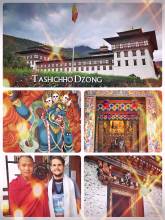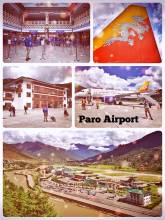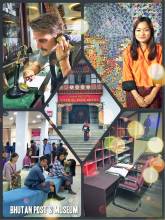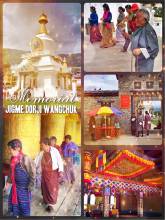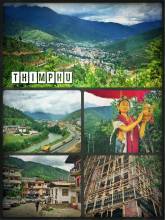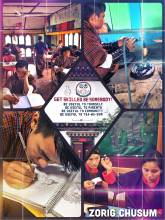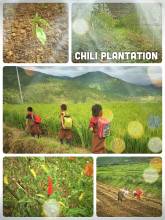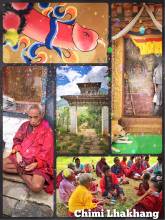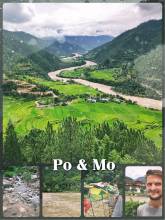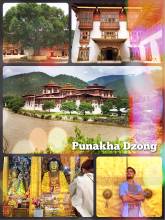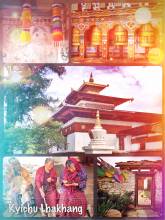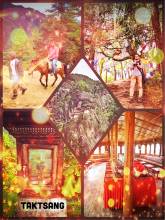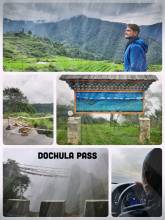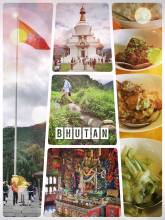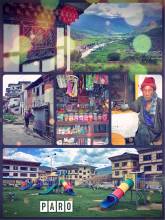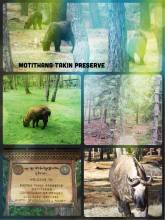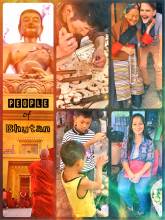Bhutan: Paro to Thimphu to Punakha
Bhutan stays isolated and preserved by choice
stays isolated and preserved by choice
Not so many people are visiting Bhutan. In comparison to some other countries, this has nothing to do with safety concerns. Bhutan has a unique visa regime, trying hard to preserve its traditions and limiting tourism. Only Indian citizens are allowed to enter the country, move around freely and even backpacking in Bhutan. The rest of the world, people like me, can only book all-inclusive guided tours. This is something I usually don’t like and don’t do, but Bhutan gave me no other choice. Such an arrangement makes even a short visit extremely expensive and exclusive. Of course, I got intrigued and wanted to see for myself what that means. Comparing prices on the internet, together with a good friend, I decided for an affordable short trip with Firefox Tours Bhutan.
Landing at the Paro Airport is not that easy
Like the visa regime already, flying to Bhutan is not such a simple task. The Buddhist kingdom lies in the middle of the Himalaya mountains. Paro International Airport is known as one of the most dangerous airports in the world, lying on 2,200 meters in a narrow valley. Never before have I descended so closely to the mountains, nearly touching the trees. After landing in this stunning scenery, you exit the aircraft into a different world. I immediately felt relaxed when setting my first foot on Bhutanese soil. The land and the people are radiating a truly grounded calmness. At the airport, we were open-heartedly welcomed by a private guide and driver. Everybody who is working in Bhutanese tourism has to wear a traditional robe, explained our private tour guide. Guide and driver always stayed with us and did everything to make our trip perfect. I’m not used to that but I had to accept it.
On a very strict tour from Paro to Thimphu
The whole trip was organized and there was no room for individual requests. Besides the relaxed baseline mood, I felt like a prisoner being chauffeured around. Not only the visa regime is strict, foreigners also have to register every single activity and movement. Even the food was pre-booked and heavily westernized. Only with some persistent persuasion, could we taste local food and visit places that were not pre-booked. The Bhutanese guide tried its best to adhere to his obligations and fulfilling our special requests. On the bright side, the tour was packed with cultural highlights. Visiting a local farmer’s market, archery ground and even a craftsmen school were all very special. Thimphu itself is not a particularly beautiful city. Driving up and down the hills around it, however, is most pleasurable. There is endless nature; green forests are covering most hills. And then there are all the Buddhist temples.
Bhutan is a true Buddhist Mountain Kingdom
Bhutan is packed with Buddhist temples and shrines. Within a few short days, we have visited nearly a dozen religious sites. Many of them were located in former defensive fortresses that now function as administrative offices, so-called Dzongs. Others were just shrines to worship both past spiritual and royal leaders. To my surprise, Bhutan is practicing a rather different Buddhism than known to the West. Most of the spiritual masters are having a warrior-like background. They used supernatural, tantric forces to defeat evil spirits. Guru Rinpoche, for example, manifested himself in eight emotional forms, having different powers. Many of them are somewhat aggressive or grim, ready to fight evil spirits. The most stunning relicts lie high up in the Himalayan mountains.
Trekking in the Eastern Himalayan mountains
No, I did not go on a multi-day trekking in the Himalayas. However, I did two independent hikes to religious sites and both were stunning! The Tiger’s Nest monastery is probably the most famous place in Bhutan, and that’s absolutely justified. The ascent takes nearly two hours and offers a stunning scenery. It was like climbing through a steep fairy-tale forest shrouded in mystic clouds. By noon, when we reached the top, most of the fog disappeared and revealed a stunning Buddhist temple built into the cliffs. I was magnified. The other hike led us high up above the Pho Chu river in Punakha. Wandering through lush green rice fields and fresh mountain streams were both enchanting and mesmerizing. Again, reaching a Buddhist monastery overlooking the panoramic landscape. The world can be such a peaceful place, sitting on a mountain rock in Bhutan.
Bhutan's Gross National Happiness Index
What is happiness and what makes people happy? Bhutan has its own way to answer these questions and they might not be too wrong. The Buddhist mountain kingdom puts a lot of emphasis on preserving its land and cultures. It claims to put the people’s well-being above the country’s economic development. After spending a few days in Bhutan and learning about its culture, I have mixed feelings. Yes, the landscape is stunning, the people are friendly and happy, and I have had a great time. But at the same time, I also felt oddly detached from the people, having no choice other than being chauffeured in a modern SUV, sleeping in luxury hotel rooms and eating westernized food. The country is heavily dependent on its neighbors and tourism. They try to teach their visitors a lesson in mindfulness and happiness but keeping them in a luxury bubble. Nevertheless, I’ve had a terrific trip and recommend everybody to visit Bhutan!
A big thanks to the Firefox Tours staff who did everything to make my trip great.





